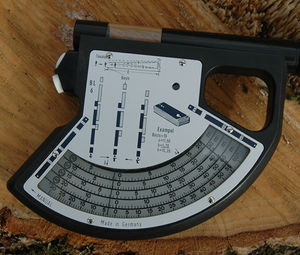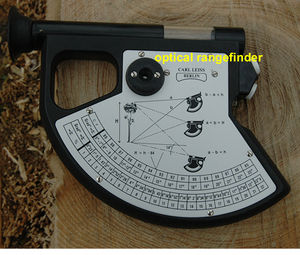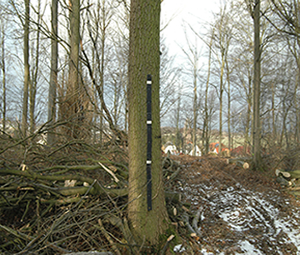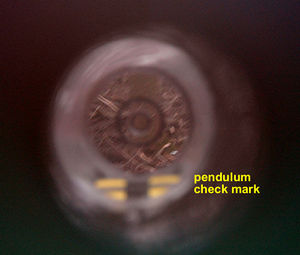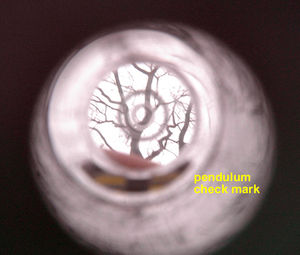Blume-Leiss
(→Handling) |
(→Handling) |
||
| Line 14: | Line 14: | ||
==Handling== | ==Handling== | ||
| − | # Determine an optimal distance to the tree by checking the view to tree bottom and top within the forest stand - preferably 15, 20, 30 or 40m. | + | # Distance measurement |
| − | # Place the levelling board at the tree. | + | ## Determine an optimal distance to the tree by checking the view to tree bottom and top within the forest stand - preferably 15, 20, 30 or 40m. |
| − | # Take place at the estimated distance to the tree and gauge the exact distance focussing the levelling the board through the optical rangefinder (figure | + | ## Place the levelling board at the tree. |
| − | # . | + | ## Take place at the estimated distance to the tree and gauge the exact distance focussing the distance levelling the board (figure 3a) through the optical rangefinder (figure 2). |
| + | ## . | ||
In figure 1 you can read the vertical height between the actor, the bottom and the top of the tree. To measure the angle of slope, the 0-mark of the levelling board (figure 3a) has to be focussed. Than one of the buttons need to be locked. | In figure 1 you can read the vertical height between the actor, the bottom and the top of the tree. To measure the angle of slope, the 0-mark of the levelling board (figure 3a) has to be focussed. Than one of the buttons need to be locked. | ||
Revision as of 08:34, 27 June 2012
| sorry: |
This section is still under construction! This article was last modified on 06/27/2012. If you have comments please use the Discussion page or contribute to the article! |
Contents |
General description
The Blume Leiss is developed to measure slope and tree height by the trigonometric principle. The device measures the elevation angle between the operator and measured points. Tree heights can directly be read from the device depending on fixed distances of 15m, 20m, 30m and 40m. For mountainous areas slope correction factors can directly be read from the device depending on the slope. Figure 1 shows the scales of height measurement for the fixed distances to the tree and the scale for slope measurement. This Blume Leiss type is called BL6, which contains 2 buttons which can separately be locked to measure tree bottom and top.
The optical rangefinder (figure 2) allows the user to measure the distance to the tree. Figure 2 shows the backside of the device where information
Handling
- Distance measurement
- Determine an optimal distance to the tree by checking the view to tree bottom and top within the forest stand - preferably 15, 20, 30 or 40m.
- Place the levelling board at the tree.
- Take place at the estimated distance to the tree and gauge the exact distance focussing the distance levelling the board (figure 3a) through the optical rangefinder (figure 2).
- .
In figure 1 you can read the vertical height between the actor, the bottom and the top of the tree. To measure the angle of slope, the 0-mark of the levelling board (figure 3a) has to be focussed. Than one of the buttons need to be locked. The distances to the tree can relatively easy be measured through the optical rangefinder (figure 2) focussing the scale bar see figure 3b. Figure 3b gives a live view while focussing the levelling board – the distance is correct, when the mid mark of the left picture is congruent with the top of the right picture of the levelling board (in this example it is 15m).
When the distance to the tree is correct, the tree height can be measured by focussing the bottom of the trunk (figure 4a) and the crown (figure 4b).
In this example the type of the device (BL6) has two lockable buttons with two separate needles (figure 1), so that the tree height between the actor and the tree bottom/tree crown can directly be read.
The difference between the measurements will be tree height –
\[ {h_t} = {h_c} - {h_b} \].
If the slope is larger than 5 degrees, the tree heights need to be corrected by the formula e*tan αi. This correction factor (CF) has to be multiplied with the tree height.
When measuring with Blume Leiss, you need to observe the pendulum check mark to be sure, that the pendulum has stopped oscillating before locking the button.
| Advantages | Disadvantages |
|---|---|
| slope correction implemented | |
| optical distance measurement | fixed distances to the tree (could be difficult in closed forest stands) |
| independence of power sources (no batteries needed) | in dark forest stand optical measurement is difficult |
| no digital storage of measurement results available. |
Applications
Related articles
[[Category: ]]
